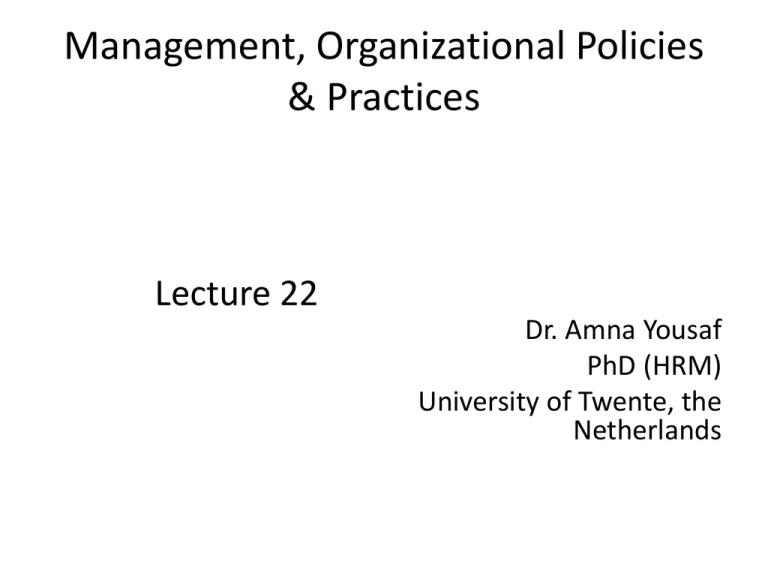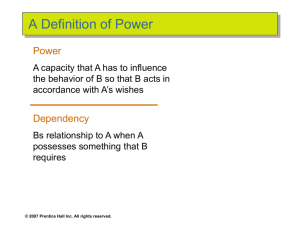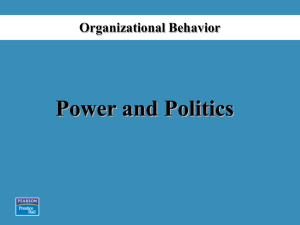
Management, Organizational Policies
& Practices
Lecture 22
Dr. Amna Yousaf
PhD (HRM)
University of Twente, the
Netherlands
Recap Lecture 21
• What is leadership
• Trait Theories of Leadership
– Big five personality model
– Limitations
• Behavioral Approaches to leadership
– Ohio State Studies/U. of Michigan
– University of Michigan Studies
• Contingency Theories of Leadership
–
–
–
–
Fiedler’s Contingency Model
Cognitive Resource Theory
Hersey and Blanchard’s Situational Leadership Model
Path Goal Theory
Recap Lecture 21
• Inspirational Approaches to Leadership
– Transformational Leaders
– Transactional Leaders
– Laissez-Faire Leadership
– Ethical Leadership
– Online Leadership
– Mentoring
© 2007 Prentice Hall Inc. All
rights reserved.
Power, Politics, Policies and
Organizational Resources
Lecture 22
Lecture Outline
•
•
•
•
•
•
•
•
•
•
What is Power?
Contrasting leadership and power
Basis of power
Dependency – the key to power
Power Tactics
Factors Influencing the Choice and Effectiveness of
Power Tactics
Political Behavior
Determinants of Political Behavior
Influences of Political Behavior
Organizational Policies and Resource Allocations
A Definition of Power
Power
A capacity that A has to influence
the behavior of B so that B acts in
accordance with A’s wishes.
Dependency
B’s relationship to A when
A possesses something
that B requires.
© 2007 Prentice Hall Inc. All
rights reserved.
Contrasting Leadership and Power
• Leadership
– Focuses on goal
achievement.
– Requires goal
compatibility with
followers.
– Focuses influence
downward.
• Research Focus
– Leadership styles and
relationships with
followers.
© 2007 Prentice Hall Inc. All
rights reserved.
• Power
– Used as a means for
achieving goals.
– Requires follower
dependency.
– Used to gain lateral and
upward influence.
• Research Focus
– Power tactics for gaining
compliance.
Bases of Power: Formal Power
Formal Power
Is established by an individual’s position in an
organization; conveys the ability to coerce or
reward, from formal authority, or from control of
information.
Coercive Power
A power base dependent on fear.
Reward Power
Compliance achieved based on
the ability to distribute rewards
that others view as valuable.
© 2007 Prentice Hall Inc. All
rights reserved.
Bases of Power: Formal Power (cont’d)
Legitimate Power
The power a person receives as a result
of his or her position in the formal
hierarchy of an organization.
© 2007 Prentice Hall Inc. All
rights reserved.
Bases of Power: Personal Power
Expert Power
Influence based on special
skills or knowledge.
Referent Power
Influence based on possession
by an individual of desirable
resources or personal traits.
© 2007 Prentice Hall Inc. All
rights reserved.
Source: Drawing by Leo Cullum in The New Yorker, copyright ©1986 The New
Yorker Magazine. Reprinted by permission.
© 2007 Prentice Hall Inc. All
rights reserved.
EXHIBIT
14–1
Dependency: The Key To Power
• The General Dependency Postulate
– The greater B’s dependency on A, the greater the power A
has over B.
– Possession/control of scarce organizational resources that
others need makes a manager powerful.
– Access to optional resources (e.g., multiple suppliers)
reduces the resource holder’s power.
• What Creates Dependency
– Importance of the resource to the organization
– Scarcity of the resource
– Nonsubstitutability of the resource
© 2007 Prentice Hall Inc. All
rights reserved.
Power Tactics
Power Tactics
Ways in which
individuals translate
power bases into
specific actions.
Influence Tactics:
• Legitimacy
• Rational persuasion
• Inspirational appeals
• Consultation
• Exchange
• Personal appeals
• Ingratiation
• Pressure
• Coalitions
© 2007 Prentice Hall Inc. All
rights reserved.
Preferred Power Tactics by Influence
Direction
Upward Influence
Downward Influence
Lateral Influence
Rational persuasion
Rational persuasion
Rational persuasion
Inspirational appeals
Consultation
Pressure
Ingratiation
Consultation
Exchange
Ingratiation
Legitimacy
Exchange
Personal appeals
Legitimacy
Coalitions
© 2007 Prentice Hall Inc. All
rights reserved.
EXHIBIT
14–2
Preferred Power Tactics by Influence
Direction
• Combination of soft and hard tactics
• Pressure tactics tend to backfire
Factors Influencing the Choice and
Effectiveness of Power Tactics
• Sequencing of tactics
– Softer to harder tactics
work best.
• Skillful use of a tactic
• Relative power of the tactic
user
– Some tactics work better
when applied downward or
upward.
• The type of request attaching
to the tactic
– Is the request legitimate?
© 2007 Prentice Hall Inc. All
rights reserved.
• How the request is perceived
– Is the request consistent
with the target’s values?
• The culture of the organization
– Culture affects user’s
choice of tactic.
• Country-specific cultural factors
– Local values favor certain
tactics over others.
Power in Groups: Coalitions
Coalitions
Clusters of individuals
who temporarily come
together to achieve a
specific purpose.
• Seek to maximize their size to
attain influence.
• Seek a broad and diverse
constituency for support of
their objectives.
• Occur more frequently in
organizations with high task
and resource
interdependencies.
• Occur more frequently if tasks
are standardized and routine.
© 2007 Prentice Hall Inc. All
rights reserved.
Politics: Power in Action
Political Behavior
Activities that are not required as part of one’s
formal role in the organization, but that influence, or
attempt to influence, the distribution of advantages
or disadvantages within the organization.
Legitimate Political Behavior
Normal everyday politics. Complaining a supervisor,
access to resources, bypassing chain of command,
networking
Illegitimate Political Behavior
Extreme political behavior that violates the implied
rules of the game. Whistle blowing, illegal strikes,
wearing orthodox dress etc
© 2007 Prentice Hall Inc. All
rights reserved.
Politics Is in the Eye of the Beholder
“Political” Label
“Effective Management” Label
1. Blaming others
vs.
Fixing responsibility
2. “Kissing up”
vs.
Developing working relationships
3. Apple polishing
vs.
Demonstrating loyalty
4. Passing the buck
vs.
Delegating authority
5. Covering your rear
vs.
Documenting decisions
6. Creating conflict
vs.
Encouraging change and innovation
7. Forming coalitions
vs.
Facilitating teamwork
8. Whistle blowing
vs.
Improving efficiency
9. Scheming
vs.
Planning ahead
10. Overachieving
vs.
Competent and capable
11. Ambitious
vs.
Career-minded
12. Opportunistic
vs.
Astute
13. Cunning
vs.
Practical-minded
14. Arrogant
vs.
Confident
15. Perfectionist
vs.
Attentive to detail
© 2007 Prentice Hall Inc. All
rights reserved.
Source: Based on T. C. Krell, M. E.
Mendenhall, and J. Sendry, “Doing
Research in the Conceptual Morass of
Organizational Politics,” paper presented at
the Western Academy of Management
Conference, Hollywood, CA, April 1987.
EXHIBIT
13–3
Factors That Influence
Political Behaviors
© 2007 Prentice Hall Inc. All
rights reserved.
EXHIBIT
14-4
Employee Responses to Organizational Politics
Moderating role of understanding
© 2007 Prentice Hall Inc. All
rights reserved.
Defensive
Behaviors
Avoiding Action:
• Overconforming
• Buck passing
• Playing dumb
Avoiding Blame:
• Stretching
• Buffing
• Stalling
• Playing safe
• Justifying
• Scapegoating
• Misrepresenting
Avoiding Change:
• Prevention
• Self-protection
© 2007 Prentice Hall Inc. All
rights reserved.
EXHIBIT
14–6
Impression Management (IM)
Impression Management
The process by which
individuals attempt to
control the impression
others form of them.
IM Techniques:
• Conformity
• Excuses
• Apologies
• Self-Promotion
• Flattery
• Favors
Source: Based on B. R. Schlenker, Impression Management (Monterey, CA:
Brooks/Cole, 1980); W. L. Gardner and M. J. Martinko, “Impression Management in
Organizations,” Journal of Management, June 1988, p. 332; and R. B. Cialdini,
“Indirect Tactics of Image Management Beyond Basking,” in R. A. Giacalone and P.
Rosenfeld (eds.), Impression Management in the Organization (Hillsdale, NJ:
Lawrence Erlbaum Associates, 1989), pp. 45–71.
© 2007 Prentice Hall Inc. All
rights reserved.
• Association
EXHIBIT
14–7
Is A Political Action Ethical?
1. What is the utility of
engaging in the behavior?
2. Does the utility balance
out any harm done by the
action?
3. Does the action conform
to standards of equity and
justice?
© 2007 Prentice Hall Inc. All
rights reserved.
EXHIBIT
14–8
Chapter Check-Up: Power & Politics
Write down two differences
between power and leadership.
Discuss with a classmate.
Do all leaders have power? Does
everyone with power lead others?
Discuss.
© 2007 Prentice Hall Inc. All
rights reserved.
Chapter Check-Up: Power & Politics
When you go to work, what three
things can you do to make people in
your organization dependent on
you? Write down your answers on a
sheet of paper.
Discuss your answers with your neighbor. Do
you think it’s bad to plan how you’ll get
power over others?
© 2007 Prentice Hall Inc. All
rights reserved.
Chapter Check-Up: Power & Politics
What is the difference
between a power tactic and
an influence tactic? Discuss
with a neighbor.
© 2007 Prentice Hall Inc. All
rights reserved.
Management Issues
Annual Objectives
Policies
Resources
Organizational structure
Management
Issues
Restructuring
Resistance to Change
Production/operations
© 2007 Prentice Hall Inc. All
rights reserved.
Human resources
Annual Objectives
•
•
•
•
•
Basis for allocating resources
Evaluation mechanisms
Establish organizational, divisional, and
departmental priorities
Horizontal consistency of objectives
Vertical consistency of objectives
© 2007 Prentice Hall Inc. All
rights reserved.
Annual Objectives
Objectives should state
–
–
–
–
Quantity
Quality
Cost
Time
© 2007 Prentice Hall Inc. All
rights reserved.
Policies
Policies set
– Boundaries
– Constraints
– Limits
Policies facilitate solving recurring problems and
guide the implementation of strategy
– Policy Manuals
© 2007 Prentice Hall Inc. All
rights reserved.
Policies
Example Issues requiring management policy --
–
–
–
–
–
–
–
To offer extensive or limited management
development workshops and seminars
To centralize or decentralize employee-training
activities
To recruit through employment agencies, college
campuses, and/or newspapers
To promote from within or hire from the outside
To promote on basis of seniroty or merit
To establish a high- or low-safety stock of inventory
To buy lease, or rent new production equipment
© 2007 Prentice Hall Inc. All
rights reserved.
Policies
• Variation in posicies such as
– 40% companies have no policies on net surfing
– Smoking policy
– Walmart “10 foot rule”
© 2007 Prentice Hall Inc. All
rights reserved.
Resource Allocation
Four types of resources
1.
2.
3.
4.
Financial resources
Physical resources
Human resources
Technological resources
© 2007 Prentice Hall Inc. All
rights reserved.
Trade off Decisions in Allocation of Resources
• Market development or penetration
• Acquire externally and/or build internally
• Contractual or permanent employees
© 2007 Prentice Hall Inc. All
rights reserved.
Thank You
© 2007 Prentice Hall Inc. All
rights reserved.






